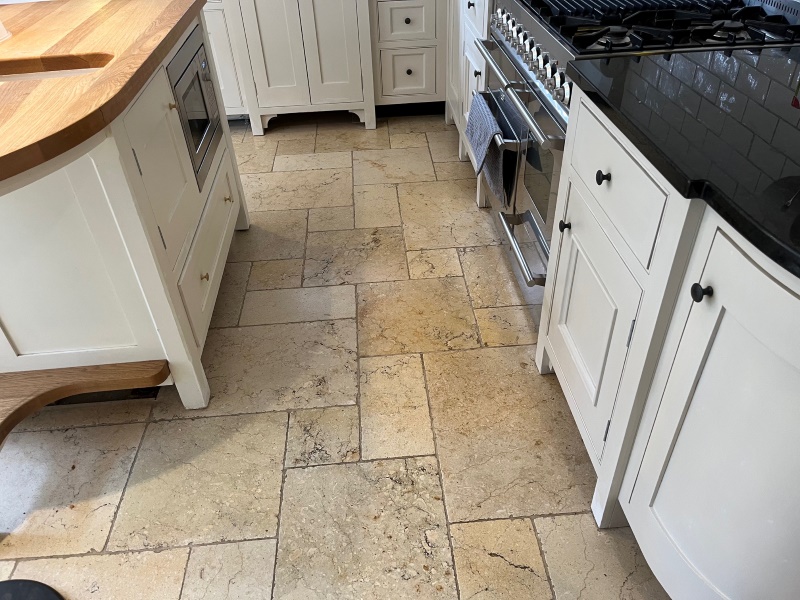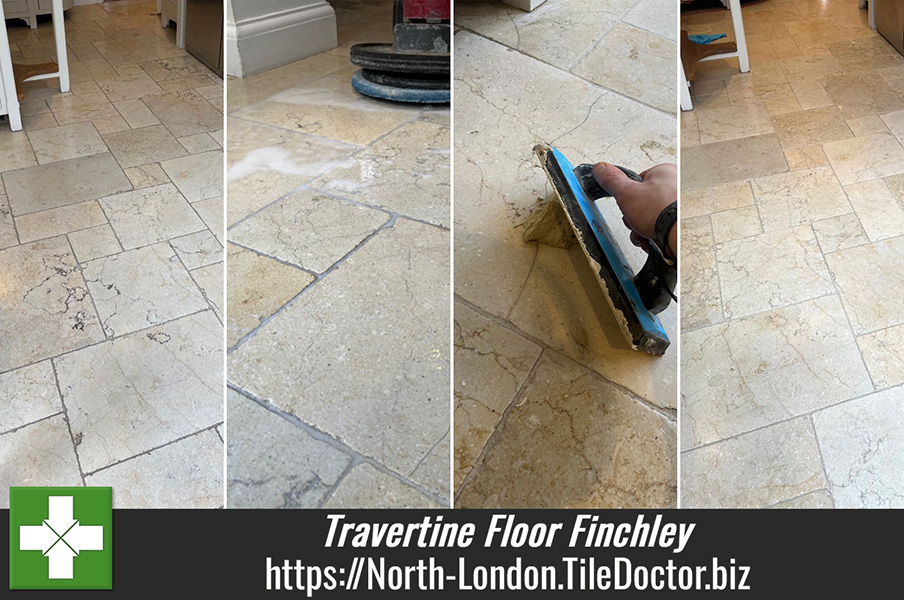Pitted and Dirty Travertine Kitchen Floor Renovated in East Finchley
Here we have a travertine floor that was installed in the kitchen of a property in East Finchley around 17 years prior. Over the years some of the grout had become loose and the sealer had worn off allowing dirt to get into the pits of the tiles. The stone and grout were now getting very dirty, and the client was struggling to keep it clean. The floor now needed renovation and I was asked to recommend a solution.

I visited the property to survey the floor, assess the issues and come up with a plan for its renovation using a set of diamond burnishing pads. From the plan I was able to email a detailed quotation over to the client which was accepted and a date agreed for the work to being.
Cleaning and Repairing a Travertine Tiled Kitchen
On the first day work started with the application of a 400-grit burnishing pad which was worked into the travertine using a floor buffer and water for lubrication. The floor was then rinsed and the slurry extracted with a wet vacuum. This process was then repeated with an 800 and then 1500 grit pad again extracting the soiling with a wet vacuum after each pad.

After working through the pads, the grout was then cleaned using Tile Doctor Pro-Clean scrubbed in with a handheld brush. I find this is the best method to get the dirt out of the grout, I also used it to get into the recessed of the pitted stone to ensure the floor was as clean as it could be.

Once happy the floor was rinsed with water and extracted several times to remove any trace of Tile Doctor Pro-Clean and loose dirt.
Sealing a Travertine Tiled Kitchen
Once the Travertine was dry, I set about refilling the loose grout and pitting in the tiles with jasmine grout (a colour that tends to be a good colour match for travertine tiles). I sponged off the excess grout and allowed the whole floor to dry overnight.

The following day the tiles were polished with a super fine 3500-grit burnishing pad that really brings up the sheen on polished stone floors. The pad is applied dry with only a little water sprayed onto the floor, a process we refer to as spray burnishing.
The last step was to apply a sealer to the floor in-order to protect it from dirt becoming ingrained in the pores of the stone. We used an impregnating sealer called Colour Grow for this, it soaks into the stone occupying the pores and thereby prevents dirt from residing there. This keeps dirt on the surface where it can be easily cleaned away. This sealer contains a colour enhancing formula which helps to bring out the natural colours in the stone, two coats were applied.

The client was delighted with the transformation before leaving I left them with a bottle of Tile Doctor Stone Soap and some advice on how to best maintain the floor. This will keep the floor in great condition over the coming months and years.

Professional Restoration of a Travertine Tiled Kitchen in East Finchley
Pitted and Dirty Travertine Kitchen Floor Renovated in East Finchley Read More »





